engine coolant SKODA OCTAVIA TOUR 2009 1.G / (1U) User Guide
[x] Cancel search | Manufacturer: SKODA, Model Year: 2009, Model line: OCTAVIA TOUR, Model: SKODA OCTAVIA TOUR 2009 1.G / (1U)Pages: 226, PDF Size: 13.11 MB
Page 97 of 226

Starting-off and Driving
96•
Let go of the key as soon as the engine starts otherwise there may be damage
to the starter.
The engine running noises ma y louder at first be louder for a short time after
starting the cold engine until oil pressure can be built up in the hydraulic valve
clearance compensation. This is quite no rmal and is not an operating problem.
If the engine does not start ...
You can use the battery of anothe r vehicle as a jump-start aid ⇒page 190.
It is only possible to tow-start vehicles fitted with a manual gearbox. The tow-
starting distance must not be more than 50 metres ⇒page 193.
WARNING
•
Never run the engine in non ventilat ed or enclosed areas. The exhaust
gases of the engine contain besides the odorless and colourless carbon
monoxide a poisonous gas - hazard! Carbon monoxide can cause uncon-
sciousness and death.
•
Never leave your vehicle unattended with the engine running.Caution
•
The starter may only be operated (ignition key position ), if the engine is not
running. If the starter is immediately operated after switching off the engine, the
starter or the engine can be damaged.
•
Avoid high engine revolutions, full throttl e and high engine loads as long as the
engine has not yet reached its normal oper ating temperature - risk of damaging the
engine!
•
Vehicles which are fitted with an exhaust gas catalyti c converter should not be
tow-started over a distance of more than 50 metres.For the sake of the environment
Never warm up the engine when the vehi cle is standing. Drive off right away.
Through this the engine reaches its operating temperature more rapidly and the
pollutant emissions are lower.
Petrol enginesThese engines are fitted with a starter system which selects the correct fuel/air
mixture for every external air temperature.•
Do not depress accelerator before and when starting engine.
•
Interrupt the attempt at starting after 10 seconds if the engine does not start
right awayand wait for about 30 seconds before repeating the attempt.
•
It is possible that the fuse on the electrical fuel pump is defect if the engine still
does not start. Check the fuse and replace it if necessary ⇒page 194.
•
Contact the nearest specialist garage to obtain professional assistance.
It may be necessary, if the engine is very hot, to slightly depress the accelerator
after the engine has started.
Diesel enginesGlow plug system
Diesel engines are equipped with a glow plug system, the preglow period being
controlled automatically in line with the coolant temperature and outside temper-
ature.
The preglow indicator light
comes on after the igniti on has been switched on.
You should not switch on any major electrical components during the heating
period otherwise the vehicle battery will be drained unnecessarily.
•
You should start the engine immediately after the glow plug warning light
has gone out.
•
The glow plug warning light will come on for about one second if the engine is
at a normal operating temperature or if the outside temperature is above +5°C.
This means that you can start the engine right away.
•
Interrupt the attempt at starting after 10 seconds if the engine does not start
right awayand wait for about 30 seconds before repeating the attempt.
•
It is possible that the fuse on the dies el preglow system is defect if the engine
still does not start. Check the fuse and replace it if necessary ⇒page 194.
•
Contact the nearest specialist garage to obtain professional assistance.
A3
s2ig.book Page 96 Monday, November 10, 2008 11:20 AM
Page 98 of 226

Starting-off and Driving97
Using the system
Safety
Driving Tips
General Maintenance
Breakdown assistance
Technical Data
Starting the engine after the fuel tank has run dry
It may take longer than normal to start the
engine after refuelling if the fuel tank has
run completely dry - up to one minute. This is because the fuel system must first of
all be filled while the attempting to start the engine.
Switching off the engine– The engine can be switched off by turning the ignition key from posi- tion into ⇒page 95, fig. 105 .
WARNING
•
Never switch off the engine before the vehicle is stationary - risk of acci-
dent!
•
The brake booster only operates when the engine is running. Greater
physical effort for braking is required when engine is switched off. Because
if you do not stop as normal, this can cause an accident and severe injuries.Caution
you should not switch the engine off right away at the end of your journey after the
engine has been operated for a lengthy period at high loads but should be allowed
it to run at idling speed for about 2 minutes . This prevents any accumulation of heat
when the engine is switched off.
Note
•
The radiator fan may continue running fo r a further 10 minutes or so after the
engine and the ignition have been switched off. The coolant fan may, however, also
switch on again after some time if the coolant temperature rises because of an
accumulation of heat in the engine or if the engine is warm and the engine
compartment is additionally heated by strong sunlight.
•
This is why particular care is required when carrying out any work in the engine
compartment ⇒page 162, “Working in the engine compartment”.
ShiftingShift into reverse only when the car is stationary. Depress the clutch pedal and hold
it fully depressed. Wait a moment before engaging reverse gear in order to avoid
any shift noises.
The reversing lights will come on once re verse gear is engaged, provided the igni-
tion is on.
WARNING
Never engage the reverse gear when driving - risk of accident!
Note
•
One should not lay the hand on the shift lever while driving the vehicle. The
pressure of the hand will be transferred to the gearshift forks in the gearbox. This
can, over a period of time, lead to early wear of the gearshift forks.
•
Depress the clutch pedal fully when changing gears, in order to avoid unneces-
sary wear and damage.
A1
Fig. 106 Shift pattern on
models fitted with 5-speed
manual gearbox
s2ig.book Page 97 Monday, November 10, 2008 11:20 AM
Page 147 of 226
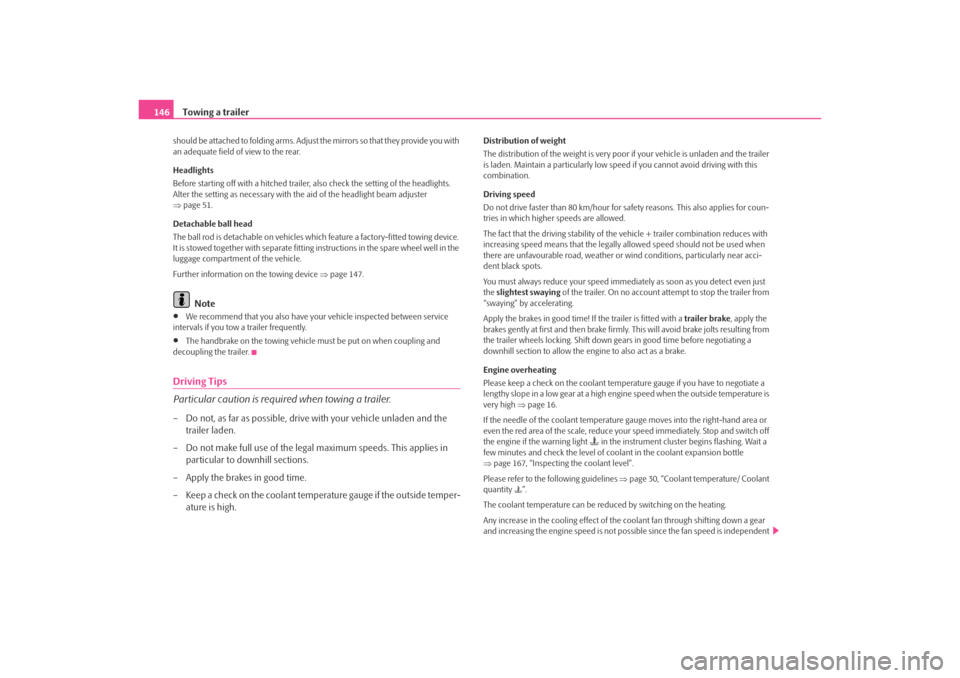
Towing a trailer
146should be attached to foldin g arms. Adjust the mirrors so that they provide you with
an adequate field of view to the rear.
Headlights
Before starting off with a hitched trailer, also check the setting of the headlights.
Alter the setting as necessary with the aid of the headlight beam adjuster
⇒ page 51.
Detachable ball head
The ball rod is detachable on vehicles wh ich feature a factory-fitted towing device.
It is stowed together with separate fitting instructions in the spare wheel well in the
luggage compartment of the vehicle.
Further information on the towing device ⇒page 147.
Note
•
We recommend that you also have yo ur vehicle inspected between service
intervals if you tow a trailer frequently.
•
The handbrake on the towing vehicle must be put on when coupling and
decoupling the trailer.
Driving Tips
Particular caution is required when towing a trailer.– Do not, as far as possible, drive with your vehicle unladen and the
trailer laden.
– Do not make full use of the legal maximum speeds. This applies in
particular to downhill sections.
– Apply the brakes in good time.
– Keep a check on the coolant temper ature gauge if the outside temper-
ature is high.
Distribution of weight
The distribution of the weight is very poor if your vehicle is unladen and the trailer
is laden. Maintain a particularly low speed if you cannot avoid driving with this
combination.
Driving speed
Do not drive faster than 80 km/hour for sa fety reasons. This also applies for coun-
tries in which higher speeds are allowed.
The fact that the driving stability of the vehicle + trailer combination reduces with
increasing speed means that the legally allowed speed should not be used when
there are unfavourable road, weather or wi nd conditions, particularly near acci-
dent black spots.
You must always reduce your speed immedi ately as soon as you detect even just
the slightest swaying of the trailer. On no account attempt to stop the trailer from
“swaying” by accelerating.
Apply the brakes in good time! If the trailer is fitted with a trailer brake, apply the
brakes gently at first and then brake firmly. This will avoid brake jolts resulting from
the trailer wheels locking. Shift down gears in good time before negotiating a
downhill section to allow the en gine to also act as a brake.
Engine overheating
Please keep a check on the coolant temperature gauge if you have to negotiate a
lengthy slope in a low gear at a high engi ne speed when the outside temperature is
very high ⇒page 16.
If the needle of the coolant temperature gauge moves into the right-hand area or
even the red area of the scale, reduce yo ur speed immediately. Stop and switch off
the engine if the warning light
in the instrument cluste r begins flashing. Wait a
few minutes and check the level of coolant in the coolant expansion bottle
⇒ page 167, “Inspecting the coolant level”.
Please refer to the following guidelines ⇒page 30, “Coolant temperature/ Coolant
quantity ”.
The coolant temperature can be reduced by switching on the heating.
Any increase in the cooling effect of the coolant fan through shifting down a gear
and increasing the engine speed is not possible since the fan speed is independent
s2ig.book Page 146 Monday, November 10, 2008 11:20 AM
Page 163 of 226
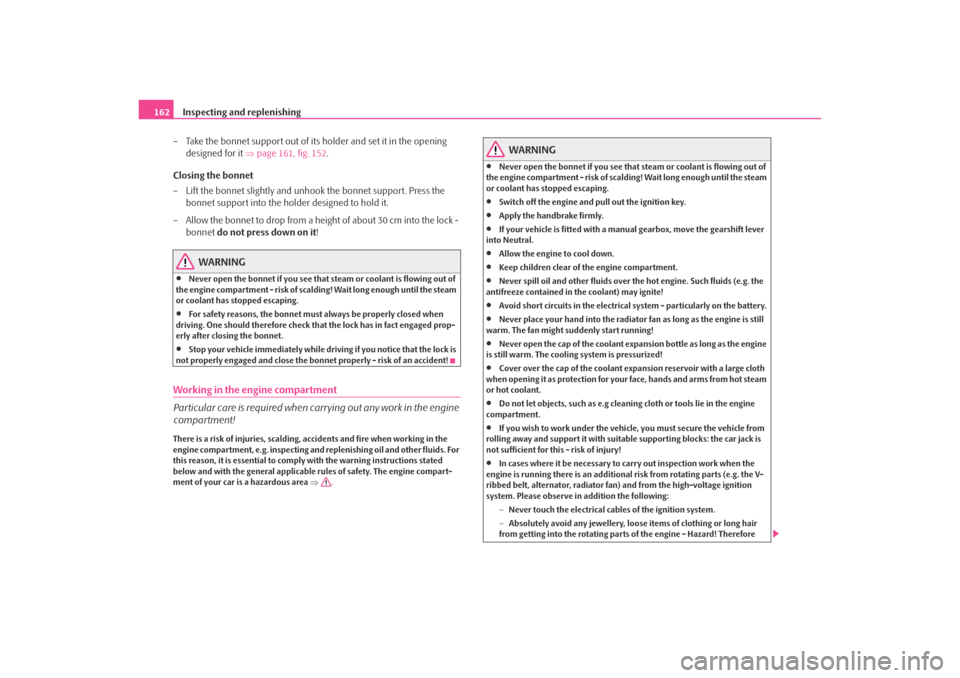
Inspecting and replenishing
162
– Take the bonnet support out of its holder and set it in the opening designed for it ⇒page 161, fig. 152 .
Closing the bonnet
– Lift the bonnet slightly and unhook the bonnet support. Press the bonnet support into the hold er designed to hold it.
– Allow the bonnet to drop from a height of about 30 cm into the lock - bonnet do not press down on it !
WARNING
•
Never open the bonnet if you see that steam or coolant is flowing out of
the engine compartment - risk of scaldi ng! Wait long enough until the steam
or coolant has stopped escaping.
•
For safety reasons, the bonnet must always be properly closed when
driving. One should therefore check that the lock has in fact engaged prop-
erly after closing the bonnet.
•
Stop your vehicle i mmediately while driving if yo u notice that the lock is
not properly engaged and close the bonn et properly - risk of an accident!
Working in the engine compartment
Particular care is required when carrying out any work in the engine
compartment!There is a risk of injuries, scalding, accidents and fire when working in the
engine compartment, e.g. inspecting an d replenishing oil and other fluids. For
this reason, it is essential to comply with the warning instructions stated
below and with the general applicable rules of safety. The engine compart-
ment of your car is a hazardous area ⇒ .
WARNING
•
Never open the bonnet if you see that steam or coolant is flowing out of
the engine compartment - risk of scaldi ng! Wait long enough until the steam
or coolant has stopped escaping.
•
Switch off the engine and pull out the ignition key.
•
Apply the handbrake firmly.
•
If your vehicle is fitted with a manual gearbox, move the gearshift lever
into Neutral.
•
Allow the engine to cool down.
•
Keep children clear of the engine compartment.
•
Never spill oil and other fluids over the hot engine. Such fluids (e.g. the
antifreeze contained in the coolant) may ignite!
•
Avoid short circuits in the electrical system - particularly on the battery.
•
Never place your hand into the radiator fan as long as the engine is still
warm. The fan might suddenly start running!
•
Never open the cap of the coolant expa nsion bottle as long as the engine
is still warm. The cooling system is pressurized!
•
Cover over the cap of the coolant expansion reservoir with a large cloth
when opening it as protection for your face, hands and arms from hot steam
or hot coolant.
•
Do not let objects, such as e.g cleaning cloth or tools lie in the engine
compartment.
•
If you wish to work under the vehicl e, you must secure the vehicle from
rolling away and support it with suitable supporting blocks: the car jack is
not sufficient for this - risk of injury!
•
In cases where it be necessary to carry out inspection work when the
engine is running there is an additional risk from rotating parts (e.g. the V-
ribbed belt, alternator, radiator fan) and from the high-voltage ignition
system. Please observe in addition the following:
−Never touch the electrical cabl es of the ignition system.
− Absolutely avoid any jewellery, loose items of clothing or long hair
from getting into the rotating part s of the engine - Hazard! Therefore
s2ig.book Page 162 Monday, November 10, 2008 11:20 AM
Page 164 of 226

Inspecting and replenishing163
Using the system
Safety
Driving Tips
General Maintenance
Breakdown assistance
Technical Data
remove any jewellery beforehand, tie up your hair and wear tight fitting
clothing.
•
Please also comply with the warnin
g instructions stated below when
carrying out any essential work on the fuel system or on the electrical
system:
−Always separate the car batter y from the electrical system.
− Do not smoke.
− Never carry out any work close to naked flames.
− Always keep a working fire extinguisher at hand.Caution
When replenishing fluids in the engine, al ways ensure that the fluids are on no
account mixed up. This may result in ma jor operating problems and also vehicle
damage!
Overview of the engine compartment
The main inspection pointsFig. 153 1.6 ltr./75 kW petrol engine1.6 ltr./75 kW petrol engine ⇒ fig. 153
Coolant expansion bottle . . . . . . . . . . . . . . . . . . . . . . . . . . . . . . . . . . .
Reservoir for hydraulic liquid of power steering
Windshield washer fluid reservoir . . . . . . . . . . . . . . . . . . . . . . . . . . .
Engine oil dipstick . . . . . . . . . . . . . . . . . . . . . . . . . . . . . . . . . . . . . . . . . .
Engine oil filler opening . . . . . . . . . . . . . . . . . . . . . . . . . . . . . . . . . . . .
Brake fluid reservoir . . . . . . . . . . . . . . . . . . . . . . . . . . . . . . . . . . . . . . . .
Battery (below a cover) . . . . . . . . . . . . . . . . . . . . . . . . . . . . . . . . . . . . .
Note
The location of the inspection points in the engine compartment of petrol and
diesel engines is practically identical.
WARNING (continued)
A1
167
A2A3
174
A4
165
A5
165
A6
169
A7
170
s2ig.book Page 163 Monday, November 10, 2008 11:20 AM
Page 168 of 226
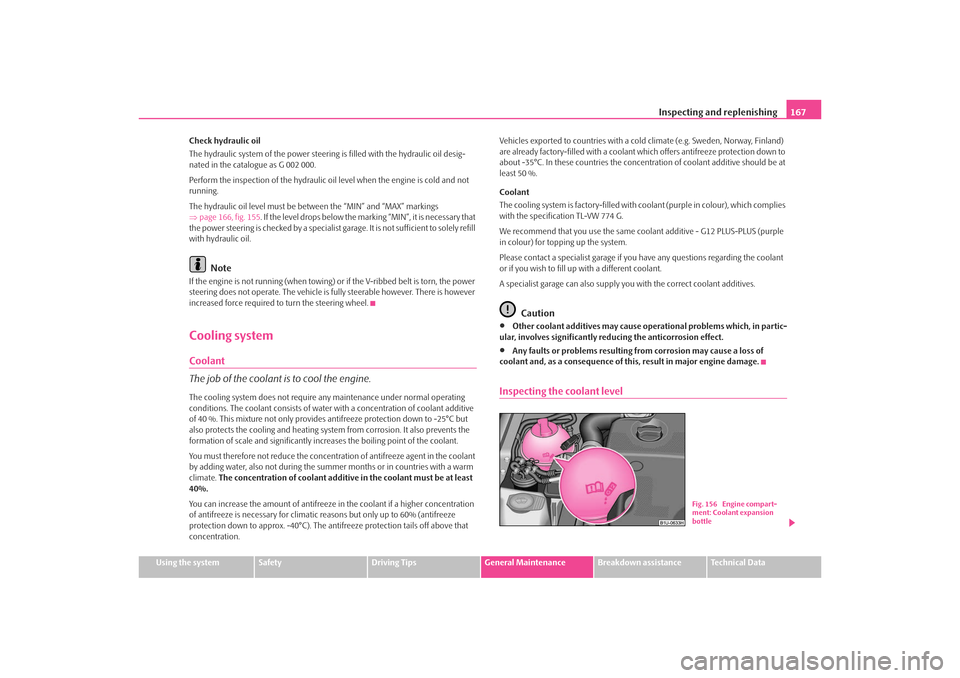
Inspecting and replenishing167
Using the system
Safety
Driving Tips
General Maintenance
Breakdown assistance
Technical Data
Check hydraulic oil
The hydraulic system of the power steering
is filled with the hydraulic oil desig-
nated in the catalogue as G 002 000.
Perform the inspection of the hydraulic oil level when the engine is cold and not
running.
The hydraulic oil level must be between the “MIN” and “MAX” markings
⇒ page 166, fig. 155 . If the level drops below the mark ing “MIN”, it is necessary that
the power steering is checked by a specialist garage. It is not sufficient to solely refill
with hydraulic oil.
Note
If the engine is not running (when towing) or if the V-ribbed belt is torn, the power
steering does not operate. The vehicle is fully steerable however. There is however
increased force required to turn the steering wheel.Cooling systemCoolant
The job of the coolant is to cool the engine.The cooling system does not require an y maintenance under normal operating
conditions. The coolant consists of water with a concentration of coolant additive
of 40 %. This mixture not only provides antifreeze protection down to -25°C but
also protects the cooling and heating system from corrosion. It also prevents the
formation of scale and significantly increases the boiling point of the coolant.
You must therefore not reduce the concentr ation of antifreeze agent in the coolant
by adding water, also not during the summ er months or in countries with a warm
climate. The concentration of coolant additive in the coolant must be at least
40%.
You can increase the amount of antifreeze in the coolant if a higher concentration
of antifreeze is necessary for climatic reasons but only up to 60% (antifreeze
protection down to approx. -40°C). The an tifreeze protection tails off above that
concentration. Vehicles exported to countries with a co
ld climate (e.g. Sweden, Norway, Finland)
are already factory-filled with a coolant which offers antifreeze protection down to
about -35°C. In these countries the concentr ation of coolant additive should be at
least 50 %.
Coolant
The cooling system is factory-filled with coolant (purple in colour), which complies
with the specification TL-VW 774 G.
We recommend that you use the same c oolant additive - G12 PLUS-PLUS (purple
in colour) for topping up the system.
Please contact a specialist garage if you have any questions regarding the coolant
or if you wish to fill up with a different coolant.
A specialist garage can also supply you with the correct coolant additives.
Caution
•
Other coolant additives may cause operational problems which, in partic-
ular, involves significantly reducing the anticorrosion effect.
•
Any faults or problems resulting from corrosion may cause a loss of
coolant and, as a consequence of th is, result in major engine damage.
Inspecting the coolant level
Fig. 156 Engine compart-
ment: Coolant expansion
bottle
s2ig.book Page 167 Monday, November 10, 2008 11:20 AM
Page 169 of 226
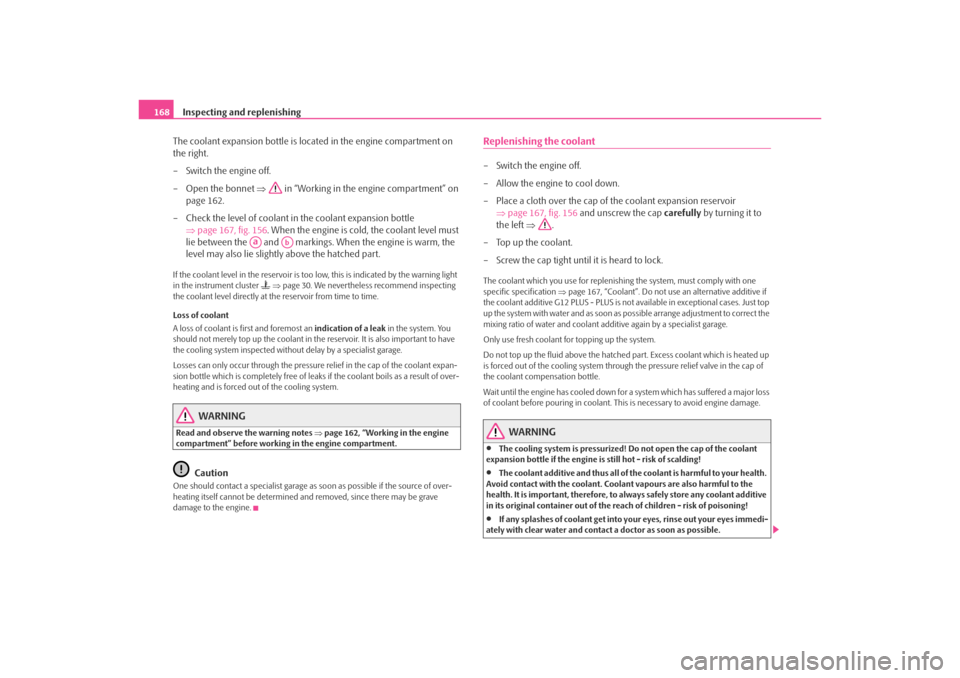
Inspecting and replenishing
168
The coolant expansion bottle is loca ted in the engine compartment on
the right.
– Switch the engine off.
– Open the bonnet ⇒ in “Working in the engine compartment” on
page 162.
– Check the level of coolant in the coolant expansion bottle ⇒page 167, fig. 156 . When the engine is cold, the coolant level must
lie between the and markings. When the engine is warm, the
level may also lie slightly above the hatched part.If the coolant level in the reservoir is too low, this is indicated by the warning light
in the instrument cluster
⇒ page 30. We nevertheless recommend inspecting
the coolant level directly at th e reservoir from time to time.
Loss of coolant
A loss of coolant is first and foremost an indication of a leak in the system. You
should not merely top up the coolant in the reservoir. It is also important to have
the cooling system inspected without delay by a specialist garage.
Losses can only occur through the pressure relief in the cap of the coolant expan-
sion bottle which is completely free of leak s if the coolant boils as a result of over-
heating and is forced out of the cooling system.
WARNING
Read and observe the warning notes ⇒page 162, “Working in the engine
compartment” before working in the engine compartment.
Caution
One should contact a specialist garage as soon as possible if the source of over-
heating itself cannot be determined and removed, since there may be grave
damage to the engine.
Replenishing the coolant– Switch the engine off.
– Allow the engine to cool down.
– Place a cloth over the cap of the coolant expansion reservoir ⇒page 167, fig. 156 and unscrew the cap carefully by turning it to
the left ⇒.
– Top up the coolant.
– Screw the cap tight until it is heard to lock.The coolant which you use for replenishing the system, must comply with one
specific specification ⇒page 167, “Coolant”. Do not use an alternative additive if
the coolant additive G12 PLUS - PLUS is not av ailable in exceptional cases. Just top
up the system with water and as soon as possible arrange adjustment to correct the
mixing ratio of water and coolant additive again by a specialist garage.
Only use fresh coolant for topping up the system.
Do not top up the fluid above the hatched part. Excess coolant which is heated up
is forced out of the cooling system throug h the pressure relief valve in the cap of
the coolant compensation bottle.
Wait until the engine has cooled down for a system which has suffered a major loss
of coolant before pouring in coolant. This is necessary to avoid engine damage.
WARNING
•
The cooling system is pressurized! Do not open the cap of the coolant
expansion bottle if the engine is still hot - risk of scalding!
•
The coolant additive and thus all of the coolant is harmful to your health.
Avoid contact with the coolant. Coolant vapours are also harmful to the
health. It is important, therefore, to always safely store any coolant additive
in its original container out of the reach of children - risk of poisoning!
•
If any splashes of coolant get into yo ur eyes, rinse out your eyes immedi-
ately with clear water and contact a doctor as soon as possible.
Aa
Ab
s2ig.book Page 168 Monday, November 10, 2008 11:20 AM
Page 170 of 226

Inspecting and replenishing169
Using the system
Safety
Driving Tips
General Maintenance
Breakdown assistance
Technical Data
•
You should also consult a doctor without delay if you have inadvertently
swallowed coolant.Caution
Do not continue your journey if for some reason it is not possible under the
conditions prevailing to top up with coolant. Switch of the engine and contact
and obtain professional assistance from a specialist garage.
For the sake of the environment
Do not re-use coolant if it is necessary to drain the coolant in the system. It should
be collected and disposed of in comp liance with environmental protection
regulations.Radiator fan
The radiator fan may switch on suddenly.The radiator fan is driven by an electric motor and controlled according to the
coolant temperature.
The radiator fan may continue running fo r up to 10 minutes after the engine has
been switched off - even if the ignition is also off. It may also switch on suddenly
after a certain time, if•
the coolant temperature has risen beca use of an accumulation of heat or
•
the warm engine compartment is heated up additionally by strong sunlight.
WARNING
You must therefore be aware when work ing in the engine compartment that
the fan may switch on suddenly - risk of injury!
Brake fluidInspecting the brake fluid levelThe brake fluid reservoir is located on the left of the engine compartment.
The brake fluid reservoir on right-hand steering models is positioned on
the other side of the engine compartment.
– Switch the engine off.
– Open the bonnet ⇒ in “Working in the engine compartment” on
page 162.
– Inspect the brake fluid level in the reservoir ⇒fig. 157 . The level must
be between the “MIN” and “MAX” markings.A slight drop in the fluid level results when driving due to normal wear-and-tear
and automatic adjustment of the br ake pads, and is perfectly normal.
There may be an indication of a leak in the brake system, however, if the fluid level
drops significantly within a short time or if it drops below the “MIN” marking. A situ-
ation where the brake fluid level is too low is indicated by the warning light
lighting up in the instrument cluster ⇒page 34. In this case stop immediately and
do not drive any further! Obtain professional assistance.
WARNING (continued)
Fig. 157 Engine compart-
ment: Brake fluid reservoir
s2ig.book Page 169 Monday, November 10, 2008 11:20 AM
Page 196 of 226
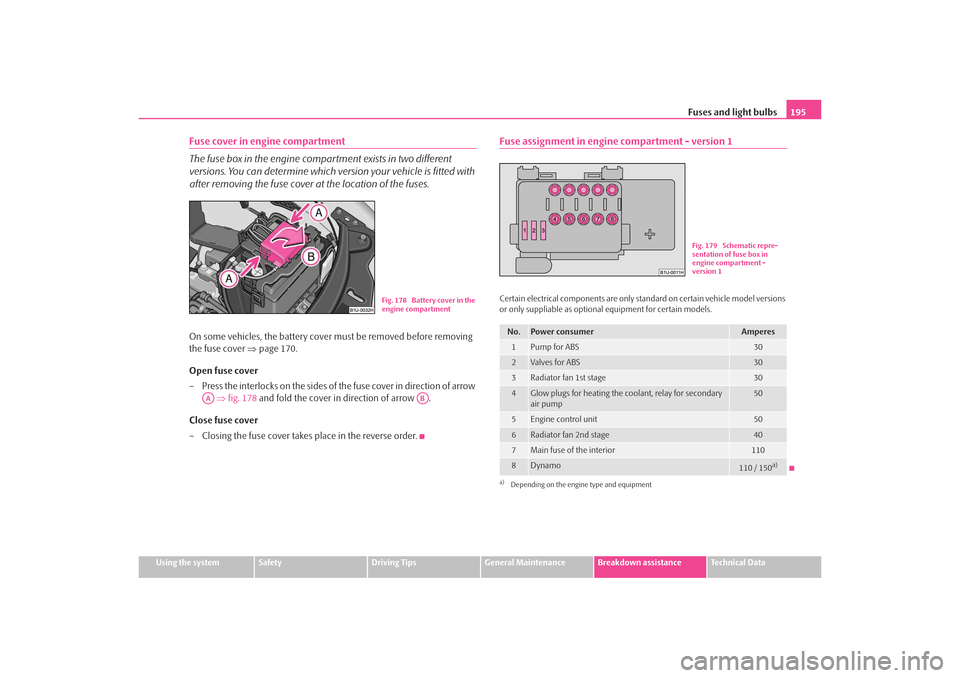
Fuses and light bulbs195
Using the system
Safety
Driving Tips
General Maintenance
Breakdown assistance
Technical Data
Fuse cover in engine compartment
The fuse box in the engine comp artment exists in two different
versions. You can determine which version your vehicle is fitted with
after removing the fuse cover at the location of the fuses.On some vehicles, the battery cover must be removed before removing
the fuse cover ⇒page 170.
Open fuse cover
– Press the interlocks on the sides of the fuse cover in direction of arrow ⇒ fig. 178 and fold the cover in direction of arrow .
Close fuse cover
– Closing the fuse cover takes place in the reverse order.
Fuse assignment in engine compartment - version 1Certain electrical components are only standard on certain vehicle model versions
or only suppliable as optional equipment for certain models.
Fig. 178 Battery cover in the
engine compartment
AA
AB
No.
Power consumer
Amperes
1
Pump for ABS
30
2
Valves for ABS
30
3
Radiator fan 1st stage
30
4
Glow plugs for heating the coolant, relay for secondary
air pump
50
5
Engine control unit
50
6
Radiator fan 2nd stage
40
7
Main fuse of the interior
110
8
Dynamo
110 / 150
a)
a)Depending on the engine type and equipment
Fig. 179 Schematic repre-
sentation of fuse box in
engine compartment -
version 1
s2ig.book Page 195 Monday, November 10, 2008 11:20 AM
Page 197 of 226
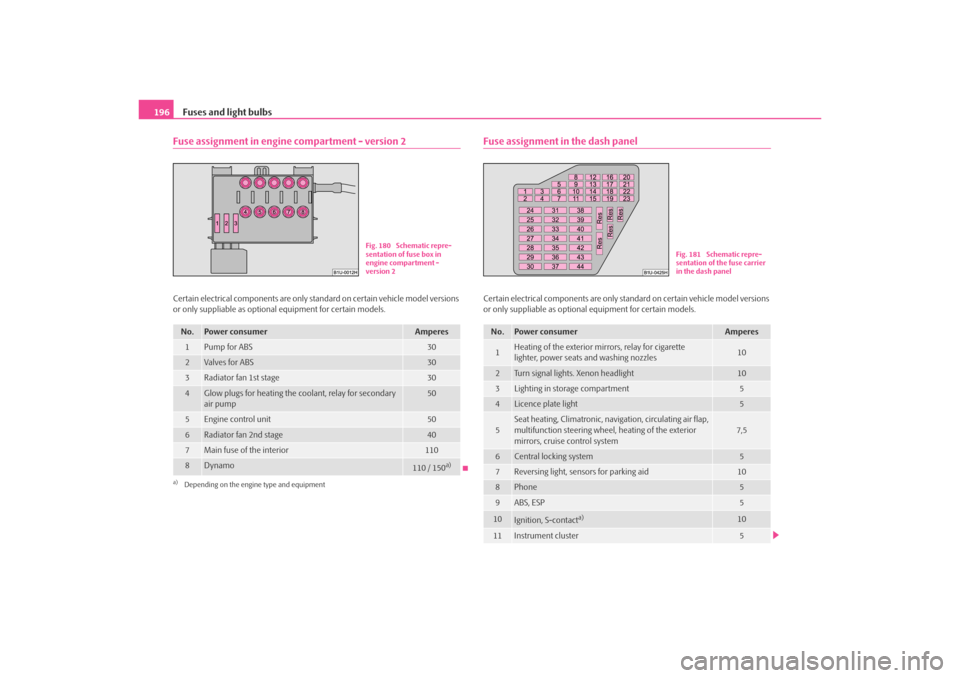
Fuses and light bulbs
196Fuse assignment in engine compartment - version 2Certain electrical components are only st andard on certain vehicle model versions
or only suppliable as optional equipment for certain models.
Fuse assignment in the dash panelCertain electrical components are only standard on certain vehicle model versions
or only suppliable as optional equipment for certain models.
No.
Power consumer
Amperes
1
Pump for ABS
30
2
Valves for ABS
30
3
Radiator fan 1st stage
30
4
Glow plugs for heating the coolant, relay for secondary
air pump
50
5
Engine control unit
50
6
Radiator fan 2nd stage
40
7
Main fuse of the interior
110
8
Dynamo
110 / 150
a)
a)Depending on the engine type and equipment
Fig. 180 Schematic repre-
sentation of fuse box in
engine compartment -
version 2
No.
Power consumer
Amperes
1
Heating of the exterior mirrors, relay for cigarette
lighter, power seats and washing nozzles
10
2
Turn signal lights. Xenon headlight
10
3
Lighting in storage compartment
5
4
Licence plate light
5
5
Seat heating, Climatronic, navigation, circulating air flap,
multifunction steering wheel, heating of the exterior
mirrors, cruise control system
7,5
6
Central locking system
5
7
Reversing light, sensors for parking aid
10
8
Phone
5
9
ABS, ESP
5
10
Ignition, S-contact
a)
10
11
Instrument cluster
5
Fig. 181 Schematic repre-
sentation of the fuse carrier
in the dash panel
s2ig.book Page 196 Monday, November 10, 2008 11:20 AM